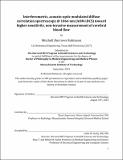Interferometric, acousto-optic modulated diffuse correlation spectroscopy @ 1064 nm (AOM-iDCS) toward higher sensitivity, non-invasive measurement of cerebral blood flow
Author(s)
Robinson, Mitchell Burrows
DownloadThesis PDF (8.024Mb)
Advisor
Franceschini, Maria Angela
Terms of use
Metadata
Show full item recordAbstract
Continuous, bedside monitoring of cerebral blood flow in patients at risk for neurovascular complications has the potential to decrease morbidity and mortality. While measures of systemic physiology can be used to infer cerebral perfusion, a technology that directly and continuously measures cerebral blood flow (CBF) is needed to properly manage treatment. Diffuse Correlation Spectroscopy (DCS) is an established optical technique that enables continuous, non-invasive, and direct measurements of CBF. The effectiveness of DCS in measuring CBF is hampered in adults by extracerebral contamination and limited depth sensitivity.
The goal of this dissertation is to extend the usefulness of DCS in the adult population through the development of new techniques, including the use of longer wavelengths (1064 nm), acousto-optic modulation, and heterodyne detection to enhance CBF sensitivity and reduce extracerebral contamination. In each domain of improvement, we develop theory to describe the detected optical signals, advance hardware to enable measurements, and characterize the performance of the developed systems in phantom and human subject experiments. Each different improvement - wavelength extension, ultrasound sonification, heterodyne detection, and time-resolved detection - has its own advantage in terms of depth sensitivity, signal-to-noise ratio, and hardware/software complexity. As such, the techniques have the potential to be mixed and matched to increase sensitivity to CBF and dramatically improve the SNR of the measurement to enable non-invasive, bedside measurements.
Date issued
2022-09Department
Harvard-MIT Program in Health Sciences and TechnologyPublisher
Massachusetts Institute of Technology